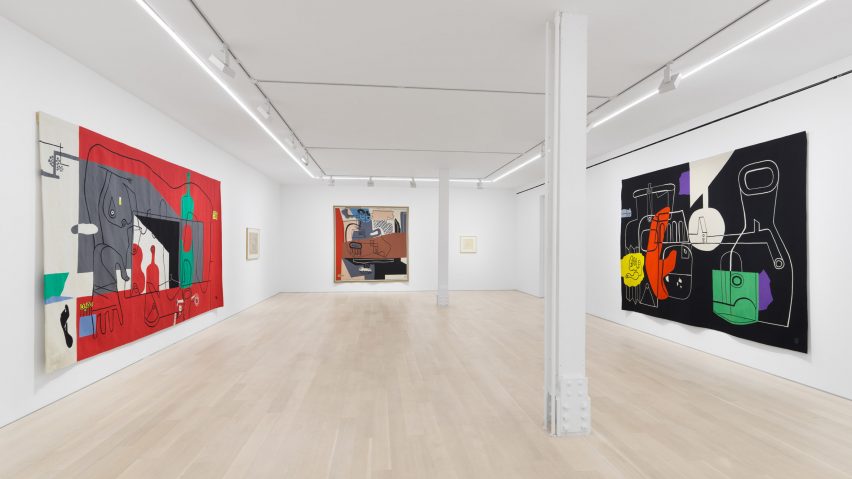Almine Rech Gallery in New York has launched its Nomadic Murals show featuring the tapestries of Swiss-French architect and designer Charles-Édouard Jeanneret, better known as Le Corbusier.
The gallery collected five of the tapestries, of which only 30 were made, to show for the exhibition named Nomadic Murals.
All the tapestries are woven representations of paintings completed by Le Corbusier, who was known for his artistic endeavours that included speculative drawings and figurative paintings.
The works were called "nomadic" because of the ability to bring the tapestries from place to place or to move them to suit the needs of specific interiors.
"I think it's important to show how deeply he was interested, concerned with, and creative in taking care of interior architecture," said gallery founder Almine Rech.
"The tradition of tapestry is very interesting, based on the idea that your 'mural' will easily travel," she told Dezeen.
Le Corbusier first entertained the possibility of having his work represented as tapestries in 1936 from his interaction with art entrepreneur Marie Cuttoli, and 12 years later he contributed the art for his first, a practice he continued until he died in 1965.
The tapestries in the collection were produced by textile artist Pierre Baudouin, who turned the original studies Le Corbusier created with paints and pencils into large-scale wall hangings.
"We have many studies that are very historic and rarely seen," Rech told Dezeen.
According to architectural historian Jean-Louis Cohen, Le Corbusier's interest in tapestry stemmed from a challenge from French painter Fernand Léger, who blamed modernist architects for imposing "smooth" and "new" forms on people.
Le Corbusier believed that tapestries had the ability to bring "warmth" to interiors, according to Cohen.
According to Cohen, Le Corbusier wrote to Brazilian architect Oscar Niemeyer to profess his enthusiasm for tapestries as a place where painting "finds its architectonic sustenance in full awareness".
"Exploring all the processes used on paper, the exhibition expresses the vividness of his imagination by unveiling the originality and strength of his woven artworks within the wider context of postwar tapestry," Cohen continued.
The gallery has included 18 of Le Corbusier's original studies alongside the finished tapestries.
A stylistic drawing that led to the largest tapestry ever designed by Le Corbusier and displayed in the High Court of Chandigarh is also on show.
"We're excited to show the original study of the mural titled Marie Cuttoli from 1936, and a gouache on paper from the study for the famous Chandigarh mural," said Rech.
The pieces in the exhibition come from private collections, from the architect's foundation in France as well as from the Le Corbusier collection at New York's Museum of Modern Art (MoMA).
Le Corbusier was born in Switzerland and became a French citizen later in life. He was known as an early proponent and producer of modernist structures and furniture.
His most iconic works include the city plan for the Indian city of Chandigarh as well as stand-alone structures such as Cité Radieuse, an experimental apartment building constructed in France in the wake of destruction left by world war two. Seventeen of his buildings have been added to UNESCO's World Heritage List.
Nomadic Murals will be on view at Almine Rech Gallery in New York from 14 September to 22 October. See our Dezeen Events Guide for information about other exhibitions, installations and talks.
The photography is by Dan Bradica.

